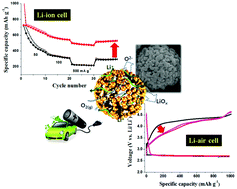A morphology, porosity and surface conductive layer optimized MnCo2O4 microsphere for compatible superior Li+ ion/air rechargeable battery electrode materials†
Abstract
Uniform surface conductive layers with porous morphology-conserved MnCo2O4 microspheres are successfully synthesized, and their electrochemical performances are thoroughly investigated. It is found that the microwave-assisted hydrothermally grown MnCo2O4 using citric acid as the carbon source shows a maximum Li+ ion lithiation/delithiation capacity of 501 mA h g−1 at 500 mA g−1 with stable capacity retention. Besides, the given microsphere compounds are effectively activated as air cathode catalysts in Li–O2 batteries with reduced charge overpotentials and improved cycling performance. We believe that such an affordable enhanced performance results from the appropriate quasi-hollow nature of MnCo2O4 microspheres, which can effectively mitigate the large volume change of electrodes during Li+ migration and/or enhance the surface transport of the LiOx species in Li–air batteries. Thus, the rationally designed porous media for the improved Li+ electrochemical reaction highlight the importance of the 3D macropores, the high specific area and uniformly overcoated conductive layer for the promising Li+ redox reaction platforms.


 Please wait while we load your content...
Please wait while we load your content...